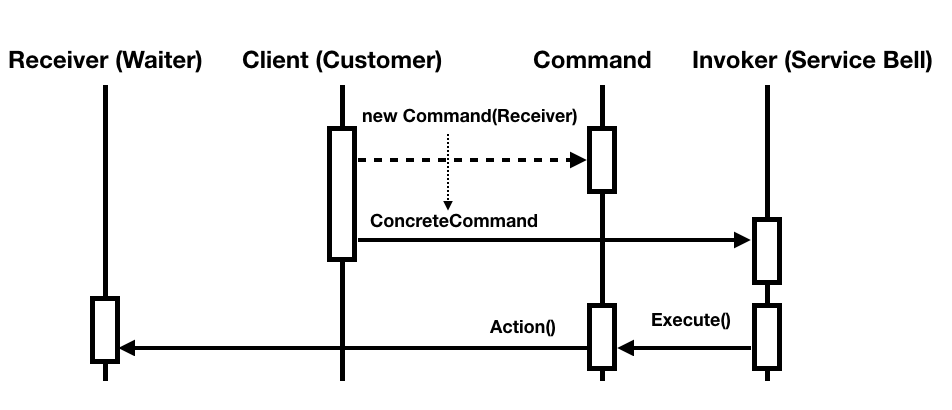用 TypeScript 輕鬆學 Design pattern - Command Pattern
前言
雖然直到最近才實際在工作上使用 TypeScript 進行開發,但是早在去年就有斷斷續續在自己的 side project 上玩玩 TypeScript,剛好後來公司讀書會在研讀經典的 Design Pattern 書籍,就索性使用 TypeScript 來製作範例,意外發現 TypeScript 在講解一些 Design Pattern 的時候非常適合,不僅能夠有類別、物件等清楚的表示,也能夠直接在網頁上做出會動的範例。
雖然這是蠻久之前製作的,但最近想想還是可以分享一下!所以今天就以 TypeScript 來製作範例,為大家講解 Command Pattern!
Command Pattern
在 GoF Design Patterns(也就是 Design Patterns: Elements of Reusable Object-Oriented Software 這本書)中 Command Pattern 屬於 Behavioural Patterns 的一種,主要是定義類別與物件之間的溝通與互動方法。
Command Pattern 的初衷,是希望能將各種對物件的操作(request)也都獨立包裝成物件,如此一來,這個 request,就能夠在各個物件對象之間傳遞,甚至提供 undoable 的 operation。
我們可以從 UML 圖來理解:

By Sae1962 - Own work, CC BY-SA 4.0, Link
Command
- 定義出一個 Command 介面,用來執行操作,該介面只需要定義一個
Execute()這個抽象 method。
- 定義出一個 Command 介面,用來執行操作,該介面只需要定義一個
Concrete Command
- 從抽象的 Command 介面所實作的 Concrete Command,會實作該 Command 實際上要執行的動作內容,也就是實作
Execute(),此外,他還需要負責將 接收操作的物件(receiver) 與 動作(Action)本身連結起來。簡單來說,就是他會被傳遞進一個物件,並且在Execute()函數中,trigger receiver 執行相對的動作。這邊值得注意的是,Concrete Command 本身並不管也不知道 receiver 會怎麼實作他們的 action,他只需要告訴 receiver 他想要完成的是什麼命令即可。
- 從抽象的 Command 介面所實作的 Concrete Command,會實作該 Command 實際上要執行的動作內容,也就是實作
Client
- 負責創建 Concrete Command,並指定其 receiver。
Invoker
- 就是下達指令的人,負責呼叫 Command。
Receiver
- 知道接受到 Command 時,要執行什麼動作(Action)的人。
光看 UML,一定還不太清楚,接著我們從 sequence diagram 來看看這幾個對象彼此之間如何互動:

可以想像,Receiver 就是餐廳服務生,而 Client 就是顧客,顧客會知道要對服務生下達指令,所以會產生 new Command(Receiver);但他可能需要透過服務鈴(Invoker),才能讓服務生真正去執行他的指令。
接著我們先來看看實際的範例。
TypeScript 實作範例
當顧客點選 “Give me food” 按鈕時,服務生就會接收到指令,並趕緊去找廚師;而當顧客想更改餐點時,可以透過 “Hey get back”,下達指令來回復服務生的上一個動作。
很簡單暴力的範例吧XD
實際上的程式怎麼寫呢?
首先我們先從定義 Command 介面開始:
1 | export class Command { |
如同先前 UML 圖所描述,我們只定義抽象的 execute() method,在 TypeScript 中要模擬抽象方法的最簡單做法就是讓他 throw Error。
另外我們同時也定義一個 unexecute(),作為回復的操作。
[2019/04/22 - Update]
感謝 @pilagod 的補充,TypeScript 有提供 Abstract 類別,可以強迫繼承者去實作其抽象函數,所以我們的 Command class 可以寫成:
1 | export abstract class Command { |
1 | import * as React from "react"; |
再來實作 ConcreteCommand,我們 extend 抽象的 Command 類別,指定兩個私有變數:receiver 與 position。
receiver 可以從其宣告的類別看出,就是 Waiter,這就是 TypeScript 適合說明 Design Pattern 的優點之一,可以很明確看到關聯性,我們待會會看到 Waiter 的實作。而 position 則是範例中我們用在 execute() 中,告訴 receiver 該如何 action 的工具,在範例中就是改變 Waiter 的位置。
在 ConcreteCommand 的 execute() 實作中,我們定義出 “這個 Command” 要讓 “其受指定的 receiver” 進行怎樣的 “action”,也就是這行:
this.receiver.current.action(this.position);
我們告訴 receiver 說,請依照 this.position 這個參數去執行你的 action,但記住,你的 action 到底是怎麼實作的我並不管你。
(這邊跟 React 相關的不做太多解釋,基本上因為我們需要在 ConcreteCommand 中去呼叫 receiver 的 action method,所以採用 React.RefObject<T> 作為 receiver 的類型,這樣我們能透過 .current 的 API 去取得 React 實體。)
看到這邊可以發現,由於我們並不需要知道 receiver 本身怎麼實作 action,所以關注點可以分離,只要管好自己這邊如何呼叫 receiver 即可。
到這邊為止,我們已經實作完 UML 中的 Command 介面與 ConcreteCommand 了,接著輪到 Receiver:
1 | import * as React from "react"; |
Receiver 也很簡單,重點在於實作 action。以範例來說,我們會從 ConcreteCommand 接收到新的 position state,所以我們要執行的動作就是 this.setState({ position }),將自身的狀態改變。透過 TypeScript,可以清楚定義 state 與 props 的型別。
Waiter 需要接收一個 ref: React.RefObject<Waiter>; 的 Props,則是與 React 實作相關,因為我是利用 const WaiterRef = React.createRef<Waiter>(); 將 Waiter 的 ref 傳遞給 ConcreteCommand。(可參考 Codesandbox 內的完整程式碼)
最後,有了指令(ConcreteCommand),有了接收指令的人(Waiter),我們來看看 Customer 要如何使用指令來呼叫 Waiter 吧:
1 | // 有刪除一些不重要的 code,i.e. style, etc. |
基本上 Customer 就是會保有 ConcreteCommand 在 state 當中,這樣才能合理的不斷下達指令。
另外也需要取得 WaiterRef 這個 props,才能在初始 ConcreteCommand 時指定其 receiver。
接著我們只要在不同功能的 button 上綁定 command 即可,分別呼叫 this.state.orderCommand.execute(); 與 this.state.orderCommand.unexecute();。
如此一來,我們就成功用 TypeScript 實作一個完整的 Command Pattern 範例啦!(完整的程式碼請看上方 CodeSandbox 連結)
Command Pattern 的 Consequences
- Command Pattern 將呼叫指令的物件與執行指令的物件切割開來,降低彼此之間耦合度。
- Command 是 first-class objects,可以被傳遞、操作與繼承。
- 可以 composite 多個 Command 到一個 Command 中,類似巨集概念。
- 增加 Command 很容易,因為你不需要更改其他的現有 Class。
實作 Command Pattern 上所需要注意的細節
- 需要思考一個 Command 該擁有多少能力,是要單純作 receiver 與 action 之間的 binding,大部分實作擺在 receiver;抑或是將大多實作自己處理掉,receiver 只是一個命令的受體?
- 是否需要支援 undo 功能,Command Pattern 設計上天生支援 undo,但實際實作上你可能會需要額外的儲存 state 來達成,會增加開發複雜度。
- 若是支援 undo,還得注意發生 error 時,會不會不斷累積,難以 debug。
結論
TypeScript 現在非常熱門,Design Pattern 則是萬年不敗,兩者搭配起來一起學習可說是天作之合!尤其是平常工作沒有機會碰觸到的話,透過這種方式學習不僅兩者皆能吸收,還能累積點小玩具。
但說起來,TypeScript 的爭議也不少,最近參加了優秀新同事們主辦的幾場 Meetup,再次燃起我對 Elm 的興趣,可惜剛到新環境,瑣事太多,還來不及有個成果分享,不過也算是有點心得,希望之後能夠分享一下。
資料來源
關於作者:
@arvinh 前端攻城獅,熱愛數據分析和資訊視覺化

留言討論